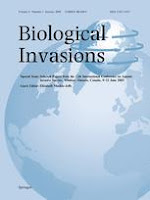Chucholl C. 2013. Invaders for sale: trade and determinants of introduction of ornamental freshwater crayfish. Biological Invasions 15(1): 125-141. http://dx.doi.org/10.1007/s10530-012-0273-2
Abstract
The trade of live ornamental freshwater crayfish has grown rapidly in the last decade and has become the major pathway for new non-indigenous crayfish species (NICS) introductions into Europe. Here, I report on the German ornamental crayfish trade, the main importer of non-indigenous crayfish into Europe. In total, 120 NICS have been available as ornamental aquarium species. One hundred and five species originate from North or Central America and are, therefore, suspected to be crayfish plague vectors. The import rate since 2005 was estimated to be seven new species per year. Despite many species being imported, only eleven species were found to be very common in the trade. In 2009, 16 online shops offered at least 37 NICS. The availability, price, and size of the offered species were used to predict their introduction status. Multiple binary logistic regression analysis showed that species’ availability and size were the principal predictors of the likelihood of being recorded as introduced from aquaria. NICS introduced from aquaria were found to be more available and larger than those present only in aquaria, and their potential invasiveness was also higher. The findings are consistent with the propagule pressure hypothesis in that a greater availability is likely related to more release events, and large species may be released more frequently as a result of overpopulating or outgrowing their aquaria. Efforts to mitigate the risk of further harmful crayfish introductions from aquaria should aim to drastically reduce the availability of high-risk species.
Keywords: live animal trade • introduction pathway • alien crayfish • aquarium discards
11 December 2012
Subscribe to:
Post Comments (Atom)







No comments:
Post a Comment